
Federico Fellini was an Italian film director and screenwriter. He is known for his distinctive style, which blends fantasy and baroque images with earthiness. He is recognized as one of the greatest and most influential filmmakers of all time. His films have ranked highly in critical polls such as that of Cahiers du Cinéma and Sight & Sound, which lists his 1963 film 8+1⁄2 as the 10th-greatest film.
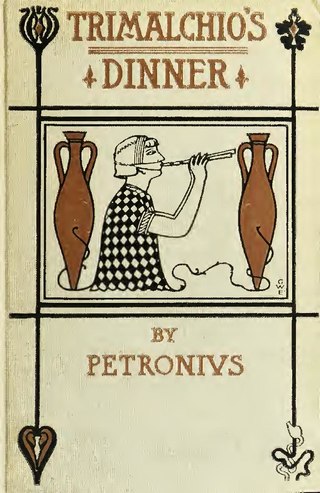
Trimalchio is a character in the 1st-century AD Roman work of fiction Satyricon by Petronius. He features as the ostentatious, nouveau-riche host in the section titled the "Cēna Trīmalchiōnis". Trimalchio is an arrogant former slave who has become quite wealthy as a wine merchant. The name "Trimalchio" is formed from the Greek prefix τρις and the Semitic מלך (melech) in its occidental form Malchio or Malchus. The fundamental meaning of the root is "King", and the name "Trimalchio" would thus mean "Thrice King" or "greatest King".

The Satyricon, Satyriconliber, or Satyrica, is a Latin work of fiction believed to have been written by Gaius Petronius in the late 1st century AD, though the manuscript tradition identifies the author as Titus Petronius. The Satyricon is an example of Menippean satire, which is different from the formal verse satire of Juvenal or Horace. The work contains a mixture of prose and verse ; serious and comic elements; and erotic and decadent passages. As with The Golden Ass by Apuleius, classical scholars often describe it as a Roman novel, without necessarily implying continuity with the modern literary form.

Amarcord is a 1973 comedy-drama film directed by Federico Fellini, a semi-autobiographical tale about Titta, an adolescent boy growing up among an eccentric cast of characters in the village of Borgo San Giuliano in 1930s Fascist Italy. The film's title is a univerbation of the Romagnol phrase a m'arcôrd. The title then became a neologism of the Italian language, with the meaning of "nostalgic revocation". The central role of Titta is based on Fellini's childhood friend from Rimini, Luigi Titta Benzi. Benzi became a lawyer and remained in close contact with Fellini throughout his life.
Gaius Petronius Arbiter was a Roman courtier during the reign of Nero. He is generally believed to be the author of the Satyricon, a satirical novel believed to have been written during the Neronian era. He is one of the most important characters in Henryk Sienkiewicz' historical novel Quo Vadis (1895). Leo Genn portrays him in the 1951 film of the same name.
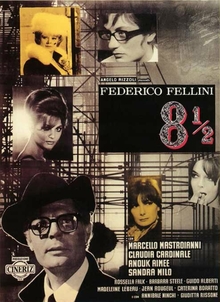
8+1⁄2 is a 1963 Italian comedy-drama film directed and co-written by Federico Fellini. The metafictional narrative centers on Guido Anselmi,, a famous Italian film director who suffers from stifled creativity as he attempts to direct an epic science fiction film. Claudia Cardinale, Anouk Aimée, Sandra Milo, Rossella Falk, Barbara Steele, and Eddra Gale portray the various women in Guido's life. The film is shot in black and white by cinematographer Gianni Di Venanzo and features a score by Nino Rota, with costume and set designs by Piero Gherardi.

La dolce vita is a 1960 satirical comedy-drama film directed and co-written by Federico Fellini. The film stars Marcello Mastroianni as Marcello Rubini, a tabloid journalist who, over seven days and nights, journeys through the "sweet life" of Rome in a fruitless search for love and happiness. The screenplay, written by Fellini and three other screenwriters, can be divided into a prologue, seven major episodes interrupted by an intermezzo, and an epilogue, according to the most common interpretation.

Juliet of the Spirits is a 1965 fantasy comedy-drama film directed by Federico Fellini and starring Giulietta Masina, Sandra Milo, Mario Pisu, Valentina Cortese, and Valeska Gert. The film is about the visions, memories, and mysticism that help a middle-aged woman find the strength to leave her philandering husband. The film uses "caricatural types and dream situations to represent a psychic landscape". It was Fellini's first feature-length color film, but followed his use of color in "The Temptation of Doctor Antonio" episode in the portmanteau film, Boccaccio '70 (1962).

Giulia Anna "Giulietta" Masina was an Italian film actress best known for her performances as Gelsomina in La Strada (1954) and Cabiria in Nights of Cabiria (1957), for which she won the Cannes Film Festival Award for Best Actress at the 1957 Cannes Film Festival.
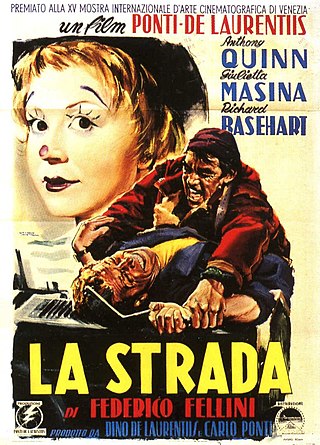
La strada is a 1954 Italian drama film directed by Federico Fellini and co-written by Fellini, Tullio Pinelli and Ennio Flaiano. The film tells the story of Gelsomina, a simple-minded young woman bought from her mother by Zampanò, a brutish strongman who takes her with him on the road.

I vitelloni is a 1953 Italian comedy drama film directed by Federico Fellini from a screenplay written by himself, Ennio Flaiano and Tullio Pinelli. It stars Franco Interlenghi, Alberto Sordi, Franco Fabrizi, Leopoldo Trieste, and Riccardo Fellini as five young Italian men at crucial turning points in their small town lives. Recognized as a pivotal work in the director's artistic evolution, the film has distinct autobiographical elements that mirror important societal changes in 1950s Italy.
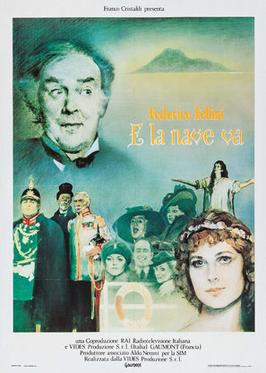
And the Ship Sails On is a 1983 Italian historical comedy-drama film directed and co-written by Federico Fellini. It depicts the events on board a luxury liner filled with the friends of a deceased opera singer who have gathered to mourn her. The film was selected as the Italian entry for the Best Foreign Language Film at the 56th Academy Awards, but was not accepted as a nominee.
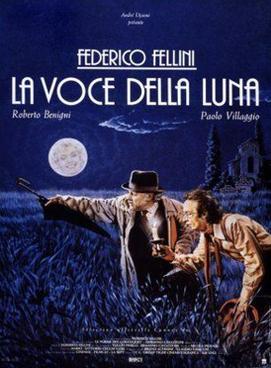
The Voice of the Moon is a 1990 Italian fantasy comedy film directed and written by Federico Fellini and starring Roberto Benigni, Paolo Villaggio, and Nadia Ottaviani. Based on the novel Il poema dei lunatici by Ermano Cavazzoni, and revisiting themes Fellini first explored in La strada (1954), the film is about a fake inspector of wells and a former prefect who wander through the Emilia-Romagna countryside of Fellini's childhood and discover a dystopia of television commercials, fascism, beauty pageants, rock music, Catholicism, and pagan ritual.

Fellini's Casanova is a 1976 Italian erotic historical drama film directed by Federico Fellini from a screenplay he co-wrote with Bernardino Zapponi, adapted from the autobiography of 18th-century Venetian adventurer and writer Giacomo Casanova, portrayed by Donald Sutherland. The film depicts Casanova's life as a journey into sexual abandonment, and his relationship with the "love of his life" Henriette. The narrative presents Casanova's adventures in a detached, methodical fashion, as the respect for which he yearns is constantly undermined by his more basic urges.
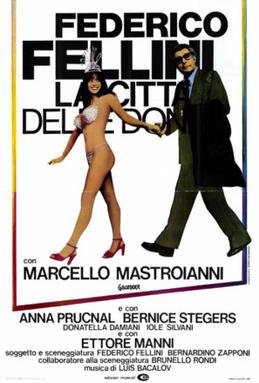
City of Women is a 1980 Italian fantasy comedy-drama film co-written and directed by Federico Fellini. Amid Fellini's characteristic combination of dreamlike, outrageous, and artistic imagery, Marcello Mastroianni plays Snàporaz, a man who voyages through male and female spaces toward a confrontation with his own attitudes toward women and his wife.
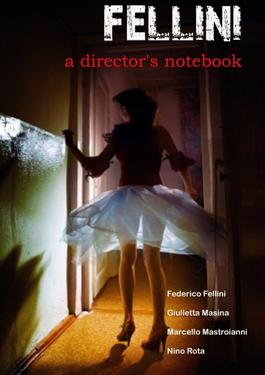
Fellini: A Director's Notebook is an Italian documentary for television directed by Federico Fellini shot in 16mm and first broadcast in the United States on NBC in 1969, on NBC Experiment in Television.

Brunello Rondi was an Italian screenwriter and film director, best known for his frequent script collaborations with Federico Fellini.

Satyricon, also named The Degenerates, is an Italian film from 1969 directed by Gian Luigi Polidoro. Like the more famous version made by Federico Fellini it is loosely based on Petronius's work, Satyricon, a series of bawdy and satirical episodes written during the reign of the emperor Nero and set in imperial Rome.

Luigi Visconti, better known by his stage name Fanfulla, was an Italian actor and comedian.

Satiricosissimo is a 1970 Italian comedy film directed by Mariano Laurenti starring the comic duo Franco and Ciccio. It is a parody of the 1969 Federico Fellini film Fellini Satyricon.
















